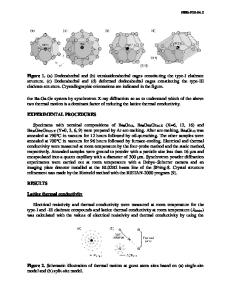Effects of Ga- and In-doping on the Thermoelectric Properties in Ba-Ge Clathrate Compounds
- PDF / 447,291 Bytes
- 6 Pages / 612 x 792 pts (letter) Page_size
- 53 Downloads / 360 Views
S4.8.1
Effects of Ga- and In-doping on the Thermoelectric Properties in Ba-Ge Clathrate Compounds Norihiko L. Okamoto and Haruyuki Inui Department of Materials Science and Engineering, Kyoto University Sakyo-ku, Kyoto 606-8501, Japan ABSTRACT The crystal structures and thermoelectric properties of Ba-Ge type-I clathrate compounds (Ba8GaXGe46-X and Ba8Ga16-YInYGe30) have been investigated as a function of Ga and In contents. Ba8GaXGe46-X alloys have a crystal structure that contains an ordered arrangement of Ge vacancies, forming a superstructure based on the normal type-I structure until X reaches 3, whereas they have the normal type-I structure when X exceeds 3. The dimensionless thermoelectric figure of merit (ZT) increases with the increase in the Ga content, exhibiting the highest value of 0.49 for Ba8Ga16Ge30. The power factor for Ba8Ga10In6Ge30 is 1.5 times that for Ba8Ga16Ge30 so that the In containing alloy exhibits a ZT value as high as 1.03 at 700°C. INTRODUCTION Clathrate compounds possess polyhedral cages encapsulating guest atoms. The cages consist of group IV and/or III elements while the guest atoms are typically alkali metals or alkali-earth metals. Clathrate compounds have been intensively investigated in hopes of producing more efficient thermoelectric devices because they generally show low thermal conductivity and relatively high electrical conductivity [1-3]. These combined properties of clathrate compounds are explained by Slack with the concept of PGEC (Phonon-Glass, Electron-Crystal) [4]. Among clathrate compounds with a variety of structures, the type-I clathrate compounds have mainly been studied for thermoelectric materials [1] because of their good electrical properties. The type-I clathrate compounds possess in general a composition of M8X46, where M stands for guest atoms and X for group IV and/or III elements. The corresponding unit cell is cubic with the space group of Pm 3 n [5]. The cage framework consists of 6c, 16i and 24k crystallographic sites, while the guest atoms are located at 2a and 6d sites. We have shown that the binary type-I clathrate compound Ba8Ge43 possesses a superstructure with the cubic space group of Ia 3 d due to the ordering of Ge vacancies at the 6c sites [6,7]. The superstructure is based on the normal type-I structure and has a lattice constant twice that of the normal type-I clathrate compounds. Ba8Ge43 shows high electrical resistivity resulting in poor thermoelectric properties. On the other hand, Ba8Ga16Ge30 possesses the normal type-I structure and exhibits good thermoelectric properties [8]. In the unit cell of this alloy, the total number of electrons donated by Ba atoms (+2x8) is equal to that accepted by Ga atoms (1x16), implying charge compensation is achieved. In view of this, charge compensation seems to play an important role in determining the thermoelectric properties. In alloys with Ga contents less than 16, charge is not compensated completely and there exist excess electrons in the unit cell because Ge atom has one more electron than Ga at
Data Loading...











